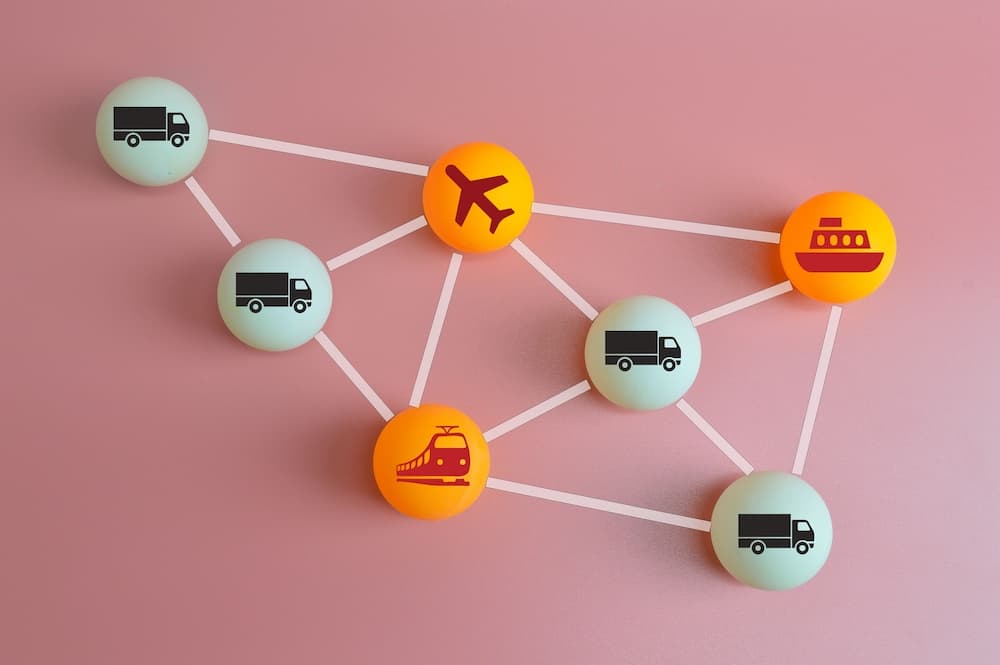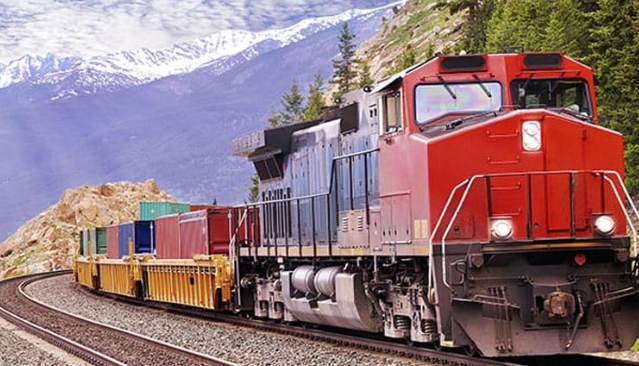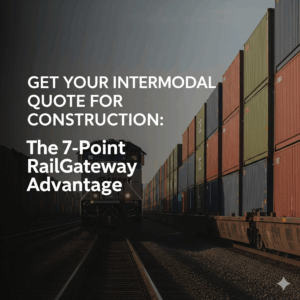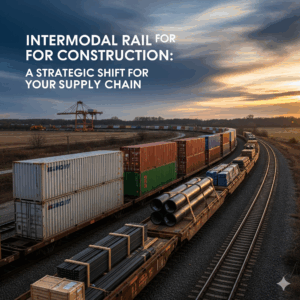This post was last updated on December, 23rd 2022
Unlocking the Power of Intermodal Shipping in 2025: Who It’s For, What It Is, Why It Works, and How It Saves You Money
In the world of modern logistics, intermodal shipping has emerged as a powerful, scalable, and cost-saving solution for Canadian businesses looking to optimize their supply chains in 2025 and beyond. But despite its growing popularity, many shippers still ask: What is intermodal shipping? Who uses it? Why is it so effective? And most importantly—how can it save my business money?
This comprehensive guide will answer all those questions and more. Whether you’re a seasoned logistics manager or a small business owner exploring freight options for the first time, understanding the fundamentals of intermodal shipping can transform how you move goods across Canada, the U.S., and beyond.
So, let’s break down the who, what, why, and how of intermodal shipping—and show you exactly how it can reduce your transportation costs, increase your efficiency, and provide long-term logistical resilience.
What Is Intermodal Shipping? A Simple Definition
At its core, intermodal shipping is the process of moving freight using two or more modes of transportation—typically rail and truck—in a single, seamless journey. What makes intermodal shipping unique is that the cargo stays in one standardized container (often a 53’ intermodal container) from origin to destination. This eliminates the need for unloading and reloading between transport legs, which saves time, reduces handling damage, and improves overall shipment security.
For example, a container might be loaded at your warehouse in Calgary, trucked to a CN or CP intermodal rail yard, transported across the country by train to Toronto, and finally delivered to its end destination by a local trucking carrier. All without your product ever leaving the container.
This efficient, multimodal movement is what defines intermodal shipping—and it’s what makes it one of the most cost-effective and sustainable freight solutions in 2025.
Who Uses Intermodal Shipping? Is It Right for Your Business?
Historically, intermodal shipping was used mostly by large retailers, automotive manufacturers, and major distributors. Today, however, a growing number of Canadian businesses of all sizes are turning to intermodal for both domestic and cross-border freight.
You should consider intermodal shipping if you:
- Regularly ship full truckloads (FTL) of goods over 500+ km
- Operate in high-volume corridors like Toronto–Vancouver, Montreal–Calgary, or cross-border into the U.S.
- Need to stabilize or reduce transportation costs
- Want to minimize your environmental impact
- Struggle with long-haul truck availability or driver shortages
- Value consistent, reliable transit times over ultra-fast delivery
In short, whether you’re moving consumer goods, packaging materials, food-grade products, or manufactured parts, intermodal shipping can be a strategic advantage—especially if you’re shipping on a regular schedule and value predictability and cost control.
Why Is Intermodal Shipping More Efficient?
One of the key reasons intermodal shipping is gaining traction in 2025 is its built-in efficiency advantages:
✅ Fuel Savings
Rail is 3–4 times more fuel-efficient than trucks. A single freight train can move the equivalent of 280 truckloads using a fraction of the fuel, resulting in lower shipping costs and significantly fewer emissions.
✅ Lower Linehaul Costs
The linehaul portion of an intermodal shipment—usually handled by rail—is typically 30% to 50% cheaper than long-haul trucking. With rising diesel prices and driver wage inflation, rail-based intermodal routes offer dependable savings.
✅ Reduced Handling
Because freight is loaded into a single container and sealed from origin to destination, there’s less risk of damage or theft. This also reduces labour costs associated with loading, unloading, and warehousing.
✅ Capacity Flexibility
Rail networks are more scalable during peak shipping seasons, helping shippers avoid capacity shortages and costly surcharges that plague over-the-road (OTR) trucking in high-demand periods.
✅ Green Shipping
With a growing emphasis on ESG (Environmental, Social, and Governance) performance, intermodal shipping supports your company’s sustainability goals. It emits up to 75% less greenhouse gas (GHG) than truck-only freight.
By capitalizing on the strengths of both rail and truck transportation, intermodal shipping offers an intelligent, high-performance logistics solution for the realities of 2025.
How Intermodal Shipping Works: Step-by-Step Process
Understanding how intermodal shipping works is key to evaluating whether it fits your business model. Here’s a simplified breakdown of the process:
1. Container Pickup
Your intermodal provider arranges for a container to be dropped at your origin location. This container is typically 53 feet long and compatible with both rail and truck chassis.
2. Drayage to Intermodal Ramp
A local truck (drayage carrier) transports the loaded container to a nearby intermodal terminal operated by CN, CP, or another rail provider.
3. Rail Linehaul
The container is loaded onto a well car (rail platform) and moved to its destination terminal via rail. This is the longest and most cost-efficient leg of the trip.
4. Drayage to Final Destination
At the destination terminal, a local drayage carrier picks up the container and delivers it to your customer, warehouse, or distribution centre.
Throughout the journey, the shipment remains sealed, secure, and fully trackable.
How Does Intermodal Shipping Save You Money?
Let’s get specific—because for most logistics professionals, the most important question is: How exactly does intermodal shipping save my business money?
📉 Lower Transportation Costs
Intermodal rail shipping often costs 15–30% less than equivalent truckload routes. Over time, those savings can add up to thousands—or even millions—for high-volume shippers.
📉 Fewer Accessorial Charges
Truck-only shipping is more susceptible to charges like detention, layovers, fuel surcharges, and peak season premiums. Intermodal minimizes or eliminates many of these.
📉 Lower Insurance Claims
Reduced handling and theft mean fewer damaged shipments and lower insurance premiums over time.
📉 Lower Carbon Tax Exposure
As governments tighten emissions regulations, intermodal shipping positions your business to stay ahead of compliance and avoid costly penalties or offset fees.
📉 Avoiding Truck Shortages and Delays
When trucking capacity is tight, rates spike. With intermodal shipping, you tap into reliable rail networks that don’t face the same driver shortage issues.
The Bottom Line: Why Intermodal Shipping Matters Now
In 2025, Canadian businesses face a complex landscape of rising transportation costs, shifting customer expectations, and intensifying pressure to operate sustainably. Intermodal shipping offers a proven path to smarter, leaner, and greener freight logistics.
It isn’t just about moving products from Point A to Point B—it’s about building a resilient supply chain that lowers costs, reduces risk, and keeps you competitive in a fast-changing market.
Table of contents
- What is intermodal shipping?
- What does full load intermodal shipment refer to?
- What is an example of intermodal transportation?
- Why is intermodal shipping so economical?
- How long does intermodal transport take?
- The different intermodal tansportation modes
- The intermodal shipping process
- What products can you ship using intermodal shipping?
- What can an intermodal container carry?
- Why is intermodal transportation necessary?
- Who should use intermodal freight transportation?

What Does Intermodal Rail Mean?
What is intermodal shipping?
Intermodal shipping is a method of transporting goods or cargo by using a combination of two or more modes of transportation to ship freight and goods from one location to another.
Intermodal freight transport can ship into the same container without handling cargo in between modes, making it one of its strengths.
What does full load intermodal shipment refer to?
When collaborating with logistics companies, you might encounter intermodal providers using specific rail industry terms that you’re unfamiliar with.
One term you may come across is ‘full load.’ In the intermodal rail shipping world, full load generally refers to a shipment that is booked to fill an entire intermodal rail container.
What is an example of intermodal transportation?
An example of intermodal transportation would be using a truck to transport goods to a train station, where the goods are then transported by rail to another destination.
This is often a more efficient and cost-effective way to move freight and cargo than using just one mode of transportation.
Why is intermodal shipping so economical?
Intermodal freight transportation container fees tend to be lower than a full truckload. They’re also easier to load on ships and unload, reducing the cost of cargo handling and labour for international shipments.
It’s also more economical than other forms of freight shipping because it can reduce the number of carriers involved in the supply chain process and cut down on the number of vehicles required to deliver a load or shipment. This is especially true when rail is involved.
How long does intermodal transport take?
The time frame for an intermodal shipment depends on what form of transportation you are using and where that destination may be located compared to your current location.
For example, North American intermodal shipment services can take a few weeks when using ship carriers for international service.
Truck, air, and train intermodal shipping services can take up to a couple of days.
And U.S cross-border delivery – well, that all depends on a variety of network capacity and carrier supply shipping restrictions.
Are you looking for more information about full load intermodal rail shipping services within North America and Canada?
Contact a RailGateway.ca customer service expert to help you with your intermodal rail quote today. We can help you save big on your next logistics shipment.

The Different Intermodal Transportation Modes
There are four modes of transportation available for intermodal shipping:
- Road transport with trucks, trailers, and truckload deliveries
- Rail intermodal transport with trains and railroads
- Airfreight with aircrafts
- Maritime transportation by boat
Intermodal freight shipping & rail service
The difference between rail and intermodal is intermodal freight services transport goods from shipper to consignee in intermodal containers by truck and rail from seaport to inland destinations.
It’s an effective form of transportation in North America, and RailGateway has been the #1 choice for intermodal shipping across Canada since 2001.
How does intermodal shipping work?
The intermodal shipping process
With international shipping costs at record highs and numerous air transportation delays, domestic intermodal shipping has become an effective and money-saving solution.
Suppose your company’s goods are transported via truck from a seaport, then loaded onto rail cars for transport inland. The intermodal transportation process can be broken as such:
- Products are loaded onto a truck bed (chassis), then driven to the docks.
- The container/ containers are then transported by truck or multiple trucks to an intermodal shipping dock nearby. This kind of freight transportation is often referred to as “drayage.”
- In order to ship or haul the containers by rail, they must first be lifted off of the chassis and onto rail cars.
- When a container is delivered to its final destination (another intermodal ramp or cross-section), it must be put back on a truck for delivery.
Once your container is on the flat car or well car, it can travel for thousands of miles before arriving at its destination.
The intermodal ramp does not only lift cargo from truck to train. They are also responsible for loading/unloading containers and trailers and all other modes that move cargo, including air intermodal shipments.
What products can you ship using intermodal shipping?
You can ship both hazardous and non-hazardous products with domestic intermodal rail shipping.
Hazardous materials require specific containers, typically a Type 7 container, and can not be interchanged.
What can an intermodal container carry?
Intermodal containers are routinely used to carry heavy machinery and equipment, furniture, non-perishable goods like clothes or electronics, and temperature-sensitive perishable goods such as seafood and medicines.
Intermodal containers can also transport liquids and refrigerated cargo. So it’s important to ensure that you book the correct intermodal shipping container for the type of cargo you’ll be sending.
The best way to answer that question is to check the type and dimensions of the containers used by your carrier or to get in touch with its team directly.
Why is intermodal transportation necessary?
The main benefits of moving freight through intermodal shipping include reduced costs, better fuel efficiency, reduced carbon footprint emissions, increased capacity in a single shipment.
There are other reasons why intermodal transport is important in the shipping market:
– Less noise pollution as trucks no longer pass through neighbourhoods or small towns
– Ease in managing the planning processes with the elimination of traffic and customs processes on major highways
– Leaner planning process, eliminating the needed support for large volume shipments that can unexpectedly disrupt supply chain networks
– Fixed departure schedules, meaning that customers can plan their intermodal deliveries, with some rail consulting of course.
For more details, look at the 7 benefits of intermodal transport on the blog!
Intermodal transportation is a critical component in the modern supply chain. It’s important to make sure you’re opting for an economical form of shipping and one that will be environmentally friendly.
Who should use intermodal freight transportation?
Intermodal shipping is available to any shipper and can help companies save money. The first and last mile is done by truck, but most of each shipment is completed by rail, assisting corporations to save on costly last-mile logistics.
Essentially the question should be, how far are you shipping?
Intermodal service can be a good choice for shippers moving goods and cargo over 800 km (500 miles) or more. Long trips require lots of fuel, but rail can help reduce this cost and promote a carbon footprint-friendly shipping mode. If your truckload must move longer than a single day, rail might be a sensible alternative.
We recommend intermodal freight service to any company transporting goods from one province to another in Canada.
Intermodal shipping is the future of transportation. With containers being cost-effective and providing unparalleled service, it’s time to try out these new ways for a successful shipment!

Conclusion
As we wrap up this in-depth look at intermodal shipping, one thing is clear: this isn’t just a logistics trend—it’s a transformative approach to modern freight transport that gives businesses a strategic edge in 2025 and beyond. Whether you’re shipping across Canada or cross-border to the United States, intermodal shipping offers a compelling combination of cost savings, environmental responsibility, operational efficiency, and long-term scalability.
But to truly appreciate the power of intermodal shipping, it’s worth revisiting its unique strengths—and why more Canadian shippers are adopting this model to future-proof their supply chains.
1. The Cost-Saving Engine of Intermodal Shipping
At the top of the list is cost-efficiency. Intermodal shipping consistently delivers savings of 10% to 30% compared to traditional over-the-road (OTR) trucking for full truckload shipments. How?
- Rail linehaul is significantly cheaper per kilometre than long-haul trucking.
- Drayage (local truck pickup and delivery) is shorter and more predictable.
- Intermodal minimizes accessorial charges like detention, layovers, and fuel surcharges.
- Reduced claims from damage or theft lower long-term freight insurance costs.
By leveraging the fuel efficiency of rail and the flexibility of local trucks, intermodal shipping balances cost with control—making it a top choice for businesses watching their bottom line.
2. Intermodal Shipping Reduces Supply Chain Risks
Supply chains in 2025 are more vulnerable than ever to disruptions: driver shortages, fuel price volatility, regulatory changes, and extreme weather can all derail traditional logistics plans. Intermodal shipping introduces stability by tapping into the reliability of rail networks, which aren’t affected by driver availability and can operate efficiently through multiple economic cycles.
Rail schedules are consistent. Terminals are secure. Freight is sealed and untouched during transit. These are all reasons why intermodal is seen not just as a cost-cutting solution, but as a risk management strategy.
3. Intermodal Shipping Supports Environmental Sustainability
Sustainability is no longer optional. Customers, stakeholders, and regulators are holding companies accountable for their environmental impact. Intermodal shipping plays a key role in helping businesses meet their ESG goals.
- Rail emits up to 75% fewer greenhouse gases than trucking.
- Moving goods via intermodal means fewer trucks on the road, reducing congestion and pollution.
- Eco-friendly logistics practices improve your brand’s reputation and align with Canadian and global emissions targets.
If your company is aiming to reduce its carbon footprint, intermodal shipping provides measurable, meaningful results.
4. Scalability Without Compromise
As your business grows, so too do your shipping needs. Intermodal shipping is designed to scale—without sacrificing reliability or increasing your costs exponentially.
Whether you’re shipping 10 containers a year or 10,000, intermodal networks like those operated by CN and CP have the infrastructure to support growing demand. During peak seasons, when truck capacity is stretched thin, intermodal shipping provides the breathing room your supply chain needs to stay on schedule.
That’s why large Canadian retailers, food distributors, and manufacturers increasingly rely on intermodal shipping for national and cross-border fulfillment.
5. Intermodal Shipping Works Across Canada’s Key Freight Corridors
One of the advantages of intermodal shipping in Canada is access to a mature rail infrastructure that spans coast-to-coast and connects seamlessly with major U.S. hubs. Strategic routes include:
- Toronto ↔ Vancouver
- Montreal ↔ Calgary / Edmonton
- Halifax ↔ Ontario / Midwest U.S.
- Toronto ↔ Chicago / Minneapolis / Kansas City
These high-volume corridors are serviced regularly, allowing businesses to enjoy predictable transit times, capacity availability, and integrated cross-border clearance with the U.S.
6. Integrated Technology for Real-Time Freight Visibility
In 2025, logistics success is powered by data. Modern intermodal shipping solutions offer full shipment visibility through GPS tracking, real-time alerts, and digital Transportation Management Systems (TMS).
You can monitor container status, track ETA updates, analyze carrier performance, and generate detailed reports—all from a single dashboard. Intermodal doesn’t mean giving up control; in fact, it often means having more data-driven insights to optimize your freight strategy.
7. Getting Started Is Easier Than You Think
One of the biggest misconceptions about intermodal shipping is that it’s difficult to set up or manage. But with the right partner, the process is simple:
- Get a shipping analysis based on your volume, routes, and priorities
- Determine container requirements and scheduling
- Let your intermodal logistics provider handle the coordination of rail and truck
- Enjoy consistent service and cost savings without extra complexity
Providers like RailGateway specialize in making intermodal shipping easy and accessible for businesses across Canada—no in-house logistics team required.
8. When Is Intermodal Shipping NOT the Right Fit?
While the benefits of intermodal shipping are substantial, it’s not perfect for every shipment. You may want to stick with truckload or expedited freight if:
- You’re shipping short distances under 400–500 km
- Your product is extremely time-sensitive and must arrive within 1–2 days
- You require frequent partial loads or less-than-truckload (LTL) service (though LTL intermodal is growing)
Even in those cases, many businesses use intermodal shipping for their long-haul or recurring routes and reserve truckload for urgent or regional deliveries.
9. The Competitive Advantage You Can’t Afford to Miss
In 2025, logistics is no longer just a back-office function—it’s a strategic business lever. Companies that leverage smarter freight solutions like intermodal shipping gain an edge in profitability, customer satisfaction, and operational resilience.
- You cut transportation costs
- You protect your shipments
- You scale efficiently
- You meet sustainability standards
- You navigate market disruptions with ease
And while your competitors struggle with driver shortages or escalating fuel prices, your business thrives—because you made the switch to intermodal shipping.
Final Thoughts: Make the Move to Intermodal with Confidence
Intermodal shipping is more than a shipping method—it’s a mindset shift toward smarter, data-driven, cost-effective logistics. In 2025, the businesses that win will be those that adapt. If you’re ready to reduce freight expenses, unlock capacity, and strengthen your supply chain, there’s no better time to explore intermodal solutions.
Working with a trusted partner like RailGateway ensures you get expert guidance, tailored service, and reliable performance from day one. Whether you’re new to intermodal shipping or ready to expand your usage, the opportunities to save and scale are real—and within reach.





